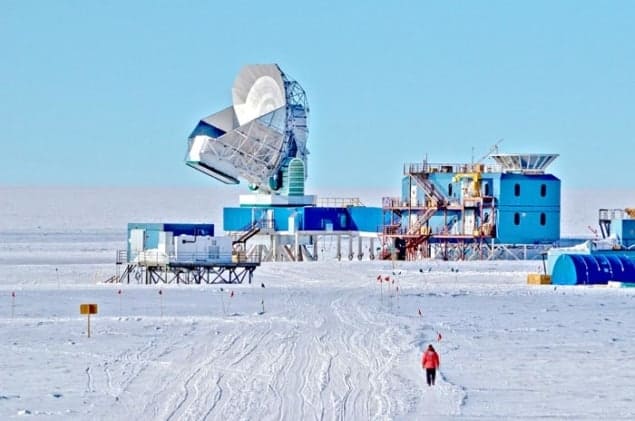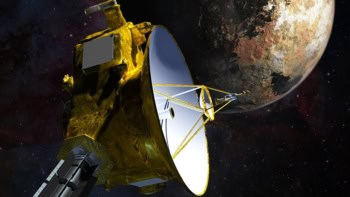
The South Pole Telescope (SPT) has made the first detection of a subtle twist in light from the cosmic microwave background (CMB), known as B-mode polarization. The signal, the existence of which has been long predicted, paves the way for a definitive test of inflation – a key theory in the Big Bang model of the universe.
“While this effect was fully expected, its detection is a milestone event in the use of the CMB to probe our universe,” says Chuck Bennett, a leading expert in CMB observation based at Johns Hopkins University in Maryland, US, who was not involved with the study. “It is solid research and I believe the result.”
Often called the afterglow of the Big Bang, the CMB is thought to have originated some 380,000 years into the life of the universe when neutral atoms first formed and space became transparent to light. Roughly speaking, it consists of microwaves with a temperature of about three kelvin, but it also contains details that have helped to refine our understanding of the early universe. The most noticeable of these details are variations in temperature of about 100 μK, which reveal density fluctuations in the early universe – the seeds of the stars and galaxies that we see today.
Polarized by scattering
The CMB does not only contain variations in temperature, however. Its radiation was scattered towards us from the universe’s earliest atoms in the same way that blue light is scattered towards us from the atoms in the sky. And in the same way that the blue light from the sky is polarized – a fact you can check by wearing polarized sunglasses – so too is the light from the CMB polarized. Variations in CMB polarization were first detected in 2002 by the DASI interferometer in Antarctica and helped cosmologists understand the dynamics of the early universe.
These polarization variations were known as E-mode or gradient variations because they describe how the magnitude of polarization changes over the CMB. But there are even subtler variations known as B-mode variations, which describe the rotation or “curl” of CMB polarization. The majority of B-mode polarization is produced by galaxies acting as gravitational lenses, twisting the E-polarized light on its 14-billion-year journey from the other side of the observable universe. It is incredibly faint, producing temperature variations of about 0.4 μK and accounting for just one part in 10 million in the CMB temperature distribution. “B-mode polarization is very difficult to measure,” says Duncan Hanson, a member of the SPT team who is based at McGill University in Canada.
The SPT has managed to detect B-mode polarization largely thanks to improvements in detector technology. Although the detection will probably have little application, it opens new doors in experimental cosmology. With more precision, B-mode signals could help cosmologists place tougher constraints on neutrino masses, which cannot be predicted in the Standard Model of particle physics.
Gargantuan ripples
But the biggest prize would be using B-mode signals to uncover evidence of primordial gravitational waves – gargantuan ripples in space–time. Such ripples are predicted to have been generated in inflation, a brief period prior to the formation of the CMB when the universe is thought to have undergone rapid expansion and given birth to large-scale structures.
Although most cosmologists today believe in inflation, the theory lacks crucial details such as how it started and stopped and there has been no way to test it. A detection of primordial gravitational waves would be strong evidence for the existence of inflation, which was first proposed back in 1980 by the American physicist Alan Guth.
“This possibility of detecting B modes from gravitational waves is a remarkable enough possibility that it is driving numerous experimental efforts,” says cosmologist Arthur Kosowsky at the University of Pittsburgh in Pennsylvania, US. “SPT is the first to detect any B modes, [and now] several other experiments are in hot pursuit, so this is the first leg in what is shaping up to be an exciting race to the finish line over the next decade.”
Others are looking
Gravitational-wave B modes could be detected by the European Space Agency’s Planck observatory, which orbits the Earth, although the toughest competition will come from the BICEP telescope, which sits alongside the SPT, or the POLARBEAR or ACT telescopes in northern Chile. If the discovery is made by one of the ground-based telescopes it would continue the tradition of ground-based experimental cosmology firsts that began with the discovery of the CMB, made by the American astronomers Arno Penzias and Robert Wilson with the horn antenna at Bell Labs in Holmdel Township in New Jersey, US, in 1964.
“Results come out from space, and there’s lots of press and beautiful results, and the ground-based work tends to get forgotten,” says John Carlstrom, the principal investigator on the SPT team who is based at the University of Chicago in Illinois, US. “But the ground-based telescopes, balloons and short-duration flights are an extremely important part of the [experimental] program and have led the way consistently since the beginning. And they still do.”
The discovery is described in the preprint arXiv:1307.5830.



